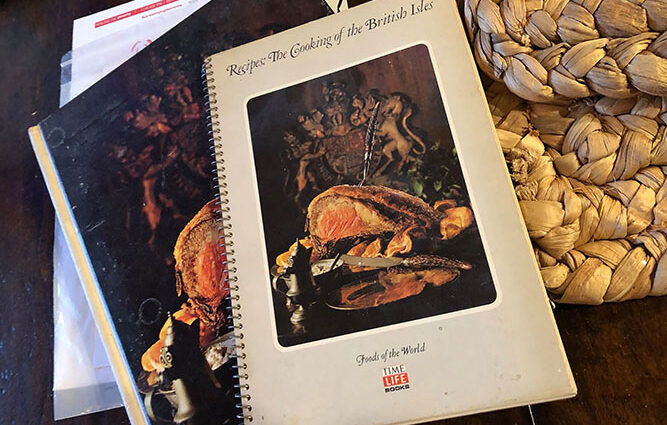I wanted to add this recipe to the collection because it has a classic Gma and Gpa story to it. During my earliest days of Anglophilia, I brought home a cookbook from TIME/LIFE’s “Foods of the World” series from my school library. It was the Cooking of the British Isles and was already pretty dated – from 1969 and the pictures reminded me of a cross between Graham Kerr’s original “Galloping Gourmet” and the Brady Bunch. I loved that book and wanted to keep it, but back in the 80’s, it wasn’t easy to find out of print books so I copied out the recipes I wanted to try, like Cornish Pasties, Roast Goose, Fish and Chips and this epic Plum Pudding that I heard about in Dicken’s Christmas Carol. I was delighted to see that Gma was just as enthusiastic as I was to try out the goose and plum pudding for one Christmas. The goose was a bomb (luckily she also made a tenderloin as well), but Gma had a great time with the plum pudding, basically pushing me over to the sidelines as she threw herself into chopping and mincing beef suet.
Gpa’s contribution was not entirely voluntary but it was important. Gpa’s sister often sent him very expensive bottles of Cognac – like Remy Martin XO which Gma decided to use instead of having to go out a buy a bottle of brandy. Gpa caught her when she was making the “brandy” hard sauce – he was shocked and speechless but in the end, he loved the plum pudding and “permitted” the use of the Cognac for the following season. It was good he didn’t know that she also used the Cognac in the pudding itself!
Eventually, Gma stopped using suet as it was labor-intensive and hard to find without the help of a nice Star Market butcher who understood what she was making – not putting out to feed birds in the winter. Today, even traditionalists like Mary Berry opt for butter as a substitute. It does make for a slightly greasy version, but still good with a nice slather of hard sauce.

- 1 1/2 cups dried currants
- 2 cups seedless raisins
- 2 cups white raisins
- 1/4 cup finely chopped candied mixed fruit peel
- 3/4 cup finely chopped candied cherries
- 1 medium-sized tart cooking apple, peeled, cored, and coarsely chopped
- 1 cup blanched slivered almonds
- 1 small carrot, scraped and coarsely chopped
- 2 tablespoons finely grated orange peel
- 2 teaspoons finely grated lemon peel
- 1/4 pound finely chopped beef suet
- 2 cups all-purpose flour
- 4 cups fresh soft bread crumbs (from white bread)
- 1 cup dark-brown sugar
- 1 teaspoon ground allspice
- 1 teaspoon salt
- 6 eggs
- 1 cup of brandy
- 1/3 cup fresh orange juice
- 1/4 cup fresh lemon juice
- 1/2 cup of brandy for serving
In a large, deep bowl, combine the currants, seedless raisins, white raisins, candied fruit peel, cherries, almonds, apple, carrot, orange and lemon peel, and beef suet, tossing them about with a spoon or your hands until well mixed. Stir in the flour, bread crumbs, brown sugar, allspice and salt.
In a separate bowl, beat the eggs until frothy. Stir in the 1 cup of brandy, the orange and lemon juice, and pour this mixture over the fruit mixture. Knead vigourously with both hands, then beat with a wooden spoon until all the ingredients are blended. Drape a dampened kitchen towel over the bowl and refrigerate for a least 12 hours.
Spoon the mixture into four 1 quart English pudding basins or plain molds, filling them to within 2 inches of their tops. Cover each mold with a strip of buttered foil, turning the edges down and pressing the foil tightly around the sides to secure it. Drape a dampened kitchen towel over each mold and tie it in place around the sides with a long piece of kitchen cord. Bring two opposite corners of the towel up to the top and knot them in the center of the mold; then bring up the remaining two corners and knot them similarly.
Place the molds in a large pot and pour in enough boiling water to come about three-fourths of the way up their sides. Bring the water to a boil over high heat, cover the pot tightly, reduce the heat to its lowest point and steam the puddings for 8 hours. As the water in the steamer boils away, replenish it with additional boiling water.
When the puddings are done, remove them from the water and let them cool to room temperature. Then remove the towels and foil and re-cover the molds tightly with fresh foil. Refrigerate the puddings for at least 3 weeks before serving. Plum puddings may be kept up to a year in the refrigerator or other cool place; traditionally, they were often made a year in advance.
To serve, place the mold in a pot and pour in enough boiling water to come about 3/4 of the way up the sides of the mold. Bring to a boil over high heat, cover the pot, reduce the heat to low and steam for 2 hours. Run a knife around the inside edges of the mold and place an inverted serving plate over it. Grasping the mold and plate firmly together, turn them over. The pudding should slide out easily
Christmas pudding is traditionally accompanied by Cumberland rum butter or brandy butter. Small paper wrapped coind (such as sixpences and threepenny bits) are sometimes pressed into the pudding as good-luck pieces just before it is served
If you would like to set a pudding aflame before you serve it, warm the 1/2 of the brandy in a small saucepan over low heat, ignite it with a match and pour it over the pudding.
